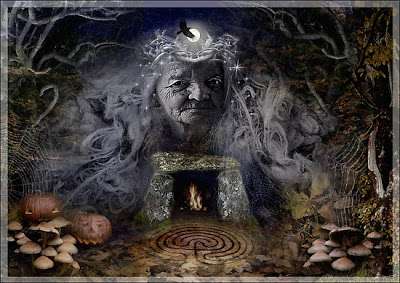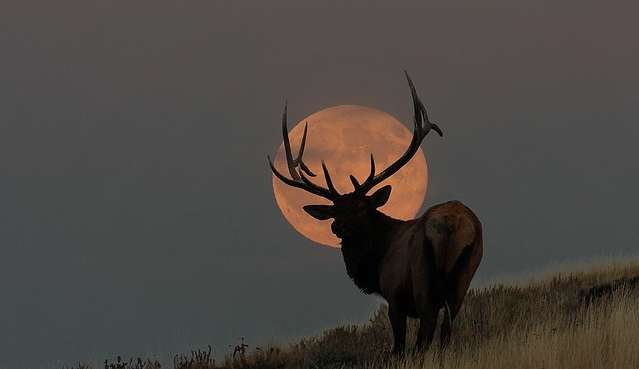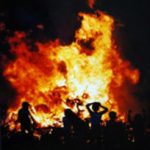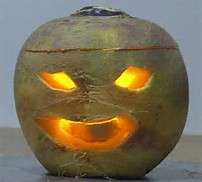
Alternative Names for Samhain: – Nos Galan Gaeaf (modern Welsh), Allantide (Cornish), All-Hallow’s Tide (“Alhalwyn-tyd,” Germanic), Halloween (secular American), Kala-Goanv (Breton), Samhiunn (Scottish Gaelic), Trinouxtion Samonii (Gaulish from the Coligny Calendar).
Celebrated on 31st October
What is Samhain?
Samhain (from Old Irish & its meaning is glossed as ‘summers end’) is a festival that marks the end of the agricultural harvest and the cattle being brought back down from the summer pastures. It is celebrated from sunset on 31 October to sunset on 1 November. This is around the halfway point between the autumn equinox and the winter solstice. Samhain marks the end of summer and the beginning of winter. An in-between time, these are special as they are neither one thing nor the other.
In Wales ‘Calan Gaeaf’ is the name of the first day of winter , observed on 1 November. The night before is Nos Galan (a mutation) Gaeaf, an Ysbrydnos (a spirit night) when the ‘veil’ is at its thinnest allowing spirits to cross between worlds.
Kindred festivals were held at the same time of year in other ‘Celtic’ lands. Samhain was marked in Ireland, Scotland and the Isle of Man, and as Kalan Gway (Cornwall) and Kalan Goañv (Brittany).
Along with Imbolc, Beltain and Lughnasadh it makes up the four ‘Agricultural’ seasonal festivals.
The Moon at Samhain
There is a school of thought that suggests that Samhain would have been celebrated on the nearest full-moon (although no empirical proof). As the dates of full moons vary (the moons orbit does not tie in with our calendar) this can be either during October or early November. The ‘Hunter’s Moon’ as it is known is so-called as it is at this time of year when the animals traditionally hunted would be at their fattest. Hunters could use the light of the full moon to ensure their food supply over the coming winter months.

Samhain Energies
Samhain is the end of Summer and the beginning of winter. As such Samhain is a liminal time. Our ancestors knew that liminal places or times were special; thresholds which are in neither side or both at the same time create gateways between the two. These liminal times also create gateways between our world and the Otherworld. Times when the spirits or Fae can easily cross and enter our world. Our ancestors believed that, at liminal times, places that also constituted a threshold were best avoided. Strong contenders which presented themselves for these locations were churchyards, stiles and crossroads and they would go out of their way to avoid them.
With the strong emphasis on liminality, Samhain is the night when the spirits of the dead can most easily mingle with the living. It is a feast/festival of the dead – not a morbid event but a celebration remembering, honouring and showing respect. Places are set at the table for recently departed relatives to join in the celebratory feast. This belief is most fitting as it is also the time of the ‘dying’ in nature.
Samhain, the end of Summer and beginning of winter, is traditionally the time to take stock. Harvest is over and the crops are in, cattle are now brought back from summer pastures where they have been since Beltane. Animals to be slaughtered for the winter are now chosen (those that wouldn’t make it through, or there wasn’t enough feed for), a custom still observed by many who keep livestock. The summer grass has gone, there is no more free foraging and it is also now, when the weather moves into the ‘freeze’ that the meat will keep.
Need Fires
Bonfires were lit; playing a large part in the celebrations down through the ages, they still do in some remote rural areas. Accounts from the 18th and 19th centuries suggest that the fires (as well as their smoke and ashes) were deemed to have protective and cleansing powers. Each household extinguished their hearth fire, then a new communal fire was lit. The fire was traditionally a ‘Need Fire’ (one lit by friction) and with the fire ablaze, the village’s cattle and swine were driven through the smoke. The heat and smoke would drive off parasites such as fleas and ticks.

In the 1850s, a Mr Taylor, of Sawrey, near Hawkshead, wrote
‘A well-to-do old farmer having lost several of his cattle by some disease then very prevalent in the neighbourhood, and being able to account for it in no way so rationally as by witchcraft, he had recourse to the following remedy, recommended to him by a weird sister in the district as an effectual protection from the attacks of the foul fiend.
A few Stones were piled together in the farmyard, and wood and straw having been laid thereon the fuel was ignited by fire obtained by friction, all the neighbours for miles around attending with their cattle to go through the solemnity. The cattle were made to pass through the fire and smoke in the order of their dignity and age, commencing with the horses and ending with the swine.
The ceremony having been duly gone through, the enlightened owners of the herds and flocks, along with their families, followed the example of the cattle, and the ‘sacrifice to Baal’ was considered complete; and the assembled throng repaired to their several homes in the full gratification of having performed a great deed.’ – As quoted by Henry Swainson Cowper, Hawkshead (1899)
You will note from this account that it wasn’t just the livestock, it was also the villagers that passed throught the heat and smoke.
Each family would then solemnly re-light its own hearth from the common flame. This is also a significant act; fire was such an unpredictable thing. There were no matches, firelighters and so on. Hearth fires were never allowed to go out, and if they did, you took a light from someone else’s fire. There was no such thing as a ‘new’ fire unless you started it the hard way with that magical ‘spark’ from friction. The need fire wasn’t just about eradicating parasites and driving off disease; it was a ‘new start’ that cut ties with past difficulties.
Samhain Folk-Lore Customs and Traditions
Moray (Scotland)
In Moray, boys asked for bonfire fuel from each house in the village. When the fire was lit, “one after another of the youths laid himself down on the ground as near to the fire as possible so as not to be burned, and in such a position as to let the smoke roll over him. The others ran through the smoke and jumped over him”. (Hutton, pp.365–368)
Yr Hwch Ddu Gwta
In Wales legend has it that a fearsome spirit called Yr Hwch Ddu Gwta took the form of a tail-less black sow and roamed the countryside with a headless woman. Children would rush home early from school. Firelight illuminates the darkness allowing escape from the Yr Hwch Ddu Gwta.
Divination
Divination has likely been a part of the festival since ancient times, and it has survived in some rural areas. At household festivities throughout the Brythonic regions there were many rituals intended to divine the future of those gathered, especially with regard to death and marriage, (Hutton p380). Apples and nuts were often used in these rituals. Apples were peeled, the peel tossed over the shoulder, and its shape examined to see if it formed the first letter of a future spouse’s name. Couples would roast nuts on the hearth and interpret their behaviour – if the nuts stayed together, so would the couple. Egg whites were dropped in water, the shapes they made foretold the number of future children. Children would also chase crows and divine some of these things from the number of birds or the direction they flew.
Mummers & Guisers
Mummers and guisers sometimes painted their faces black maybe to represent the dead or to disguise themselves from both the living and roaming spirits. “This was a part of Samhain from at least the 16th century and was recorded in parts of Ireland, Scotland, Mann and Wales. It involved people going from house to house in costume (or in disguise), usually reciting songs or verses in exchange for food”, (Hutton pp 380-382). Hutton writes: “When imitating malignant spirits it was a very short step from guising to playing pranks”. Playing pranks at Samhain is recorded in the Scottish Highlands as far back as 1736 and was also common in Ireland, which led to Samhain being nicknamed “Mischief Night” in some parts.
Coelcerth (Welsh meaning Bonfire)
This refers to a practice in which a family would either write their names or otherwise leave their mark of ownership on stones. These stones would then be put either in a fire or around a fire. After which, the family would go to sleep. In the morning, if a stone had been burned clean, it was believed that its owner would enjoy good luck in the coming year. Unfortunately, if a stone went missing, that was much more serious because that signalled that its owner would die in the coming year.
Eiddiorwg Dalen
Ground ivy was apparently to be avoided because it could cause people to see witches while they slept. However, there were ways for the clever to turn it into a tool for seeing the future in their dreams. For prophetic dreams a boy should cut ten ivy leaves, throw away one and put the rest under his head before he sleeps. A girl should take a wild rose grown into a hoop, creep through it three times, cut it in silence, and go to bed with it under her pillow.
Teiliwr
Certain professions were considered to be magical in their own right. Blacksmiths are a well-known example, which is why there are so many stories about blacksmiths getting the better of the Devil. However, local lore in Glamorgan apparently attributes witchcraft to tailors of all people, meaning that is one more profession to be extra-respectful around.
Banefire
It was traditional in many areas for the bones of the slaughtered cattle to be thrown onto the fire. which is where we get the modern word ‘bonfire’ from. Middle English – ‘Banefire’, a fire of bones. The spelling in the word’s earliest attestation is in the form banefyre, and bane is a spelling of bone which long continued common in Scotland.

Samhain Jack-o’-lantern
Carving vegetables has been a common practice in many parts of the world for hundreds of years. At Samhain, in the Brythonic speaking areas, turnips were hollowed out to act as lanterns. Very often being carved with grotesque faces; those who made them saying they were to ‘ward off evil spirits’.
In the 18thC they were known as a “Hoberdy’s Lantern” in Worcestershire, it was also common practice for ‘guisers’ to carry them to frighten people. The name was originally used to describe the strange flickering light phenonomon over bogs. These lights were also known as will-o’-the-wisp. They are of course a forerunner to todays American Halloween Pumpkins.
To understand how these celebrations came about and what they are check out Sacred Celebrations